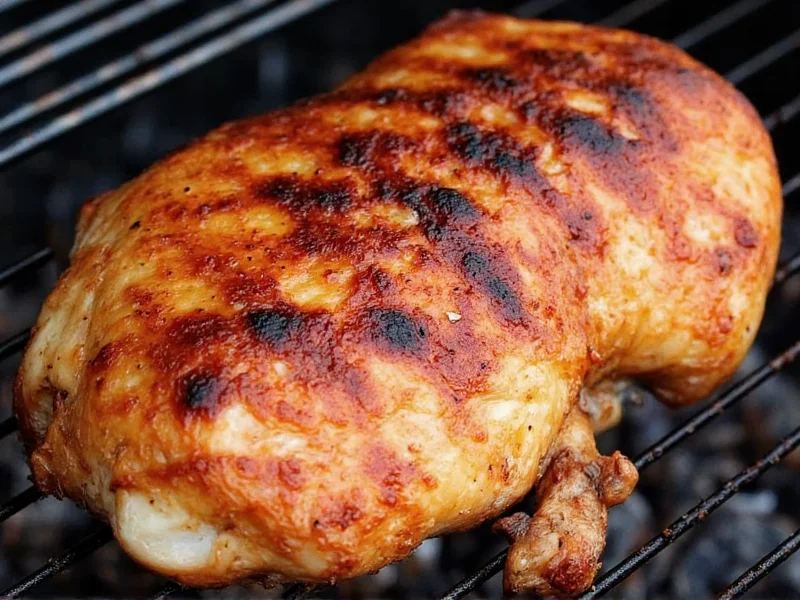Smoking chicken breast transforms this lean cut into a tender, flavorful dish when done correctly. Unlike dark meat, chicken breast requires careful attention to prevent dryness while achieving that perfect smoky flavor. This guide provides professional techniques developed through years of barbecue experience to help you master smoked chicken breast every time.
Essential Equipment for Smoking Chicken Breast
Before starting, gather these smoking essentials:
- Quality smoker (offset, pellet, electric, or charcoal)
- Meat thermometer (dual-probe recommended)
- Wood chips or chunks (fruitwoods work best)
- Drip pan or water pan
- Aluminum foil for wrapping (optional)
- Sharp knives for trimming
Choosing the Right Wood for Smoking Chicken Breast
The best wood for smoking chicken breast comes from fruit or nut trees that provide mild, complementary flavors without overwhelming the delicate poultry. Avoid strong woods like hickory or mesquite which can dominate chicken's subtle flavor.
| Wood Type | Flavor Profile | Best For |
|---|---|---|
| Apple | Sweet, mild fruitiness | All chicken preparations |
| Cherry | Sweet with subtle tartness | Enhancing natural poultry flavor |
| Pecan | Nutty, milder than hickory | Longer smoking sessions |
| Alder | Delicate, slightly sweet | Fish and poultry |
Preparing Chicken Breast for Smoking
Proper preparation makes the difference between dry and succulent smoked chicken. Start with quality boneless, skinless chicken breasts, preferably of uniform thickness. Trim excess fat and connective tissue, then consider these preparation methods:
Brining Options
Wet brine (recommended for beginners): Submerge chicken in a solution of 4 cups water, 1/4 cup salt, 1/4 cup sugar, and aromatics for 2-4 hours. This helps keep chicken breast moist when smoking by enhancing moisture retention.
Dry brine: Rub 1 tablespoon kosher salt per pound of chicken and refrigerate uncovered for 1-24 hours. This concentrates flavor while improving texture.
Seasoning Techniques
After brining (or if skipping brine), apply a thin layer of binder like mustard or oil, then generously coat with your dry rub. For a balanced smoked chicken breast recipe for beginners, try this simple rub:
- 2 tbsp paprika
- 1 tbsp garlic powder
- 1 tbsp onion powder
- 1 tsp black pepper
- 1 tsp salt
- 1/2 tsp cayenne (optional)
The Smoking Process: Step-by-Step
Follow these steps for perfectly smoked chicken breast every time:
- Preheat smoker to 225-250°F with your chosen wood
- Prepare smoker with water pan to maintain humidity
- Place chicken on smoker grates, thicker parts toward heat source
- Smoke undisturbed for 45-60 minutes (avoid frequent opening)
- Monitor internal temperature starting at 45 minutes
- Remove at 160°F (temperature will rise 5° during rest)
- Rest 10 minutes before slicing against the grain
Temperature and Timing Guide
Understanding the relationship between smoker temperature and cooking time is crucial. The ideal temperature for smoking chicken breast ranges from 225-250°F. Lower temperatures increase smoke absorption but risk drying out lean chicken breast.
Most chicken breasts reach the safe smoked chicken breast internal temperature of 165°F in 60-90 minutes at 225°F. The exact time depends on thickness and smoker consistency. Never rely solely on time—always verify with a thermometer.
Troubleshooting Common Issues
Dry chicken: This troubleshooting dry smoked chicken breast issue usually stems from overcooking or insufficient brining. Chicken breast has minimal fat, so moisture retention techniques are essential. Try brining longer or wrapping in bacon.
Uneven cooking: Rotate chicken halfway through smoking if your smoker has hot spots. Position thicker portions toward the heat source.
Bitter smoke flavor: Caused by smoldering wood rather than clean smoke. Maintain proper airflow and avoid overloading with wood chips.
Serving Suggestions
Slice smoked chicken breast against the grain for maximum tenderness. Serve with:
- Fresh herb sauces ( chimichurri or pesto)
- Roasted vegetables
- Light grain salads
- Simple pan sauces made from smoker drippings
Leftover smoked chicken breast works wonderfully in salads, sandwiches, or chopped for quesadillas. Store in airtight containers for up to 4 days.
Advanced Techniques for Perfect Results
For restaurant-quality results, try these professional methods:
The reverse sear method: After smoking to 150°F, finish on a hot grill for 2-3 minutes per side to develop a flavorful crust while maintaining interior moisture.
Butter basting: During the last 15 minutes of smoking, baste with melted butter mixed with herbs for added richness.
Smoke tube technique: For electric smokers with limited smoke production, use a smoke tube filled with wood pellets to enhance smoke flavor without raising temperature.











 浙公网安备
33010002000092号
浙公网安备
33010002000092号 浙B2-20120091-4
浙B2-20120091-4